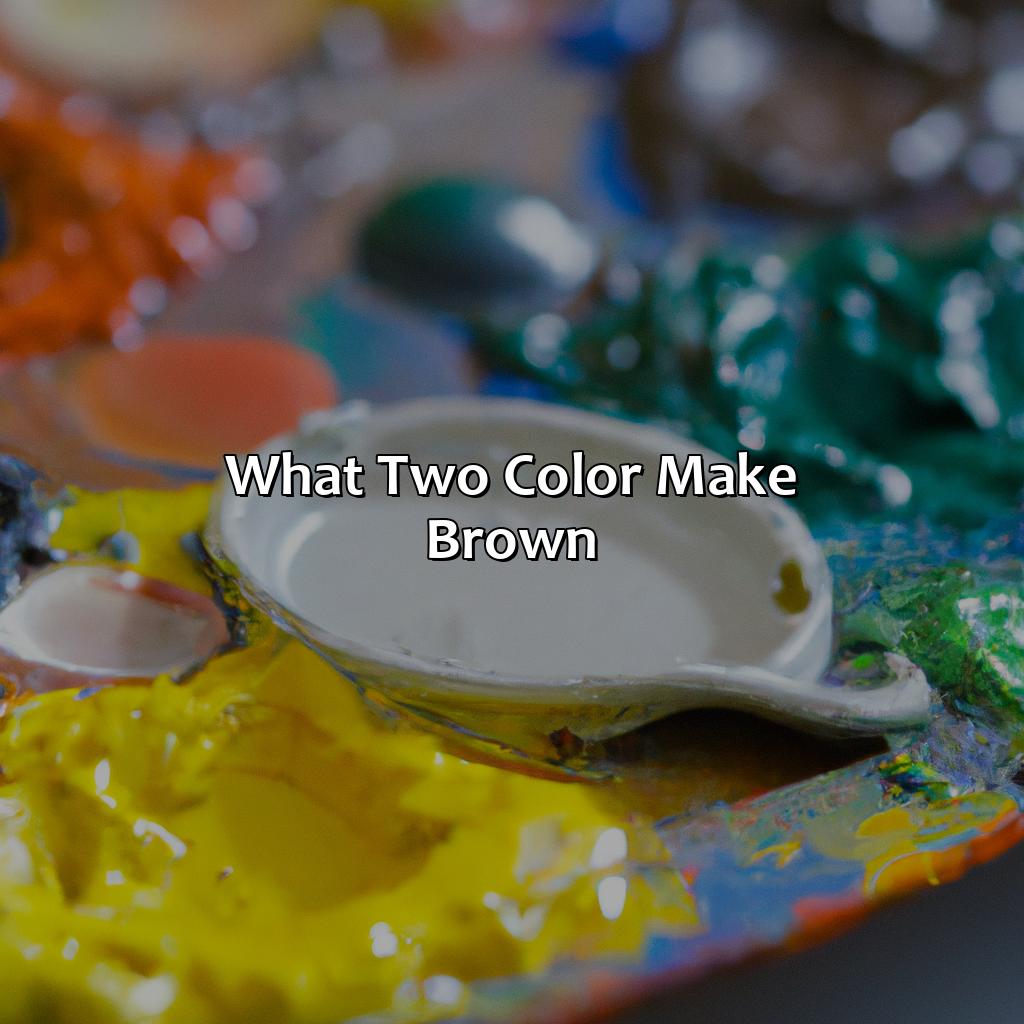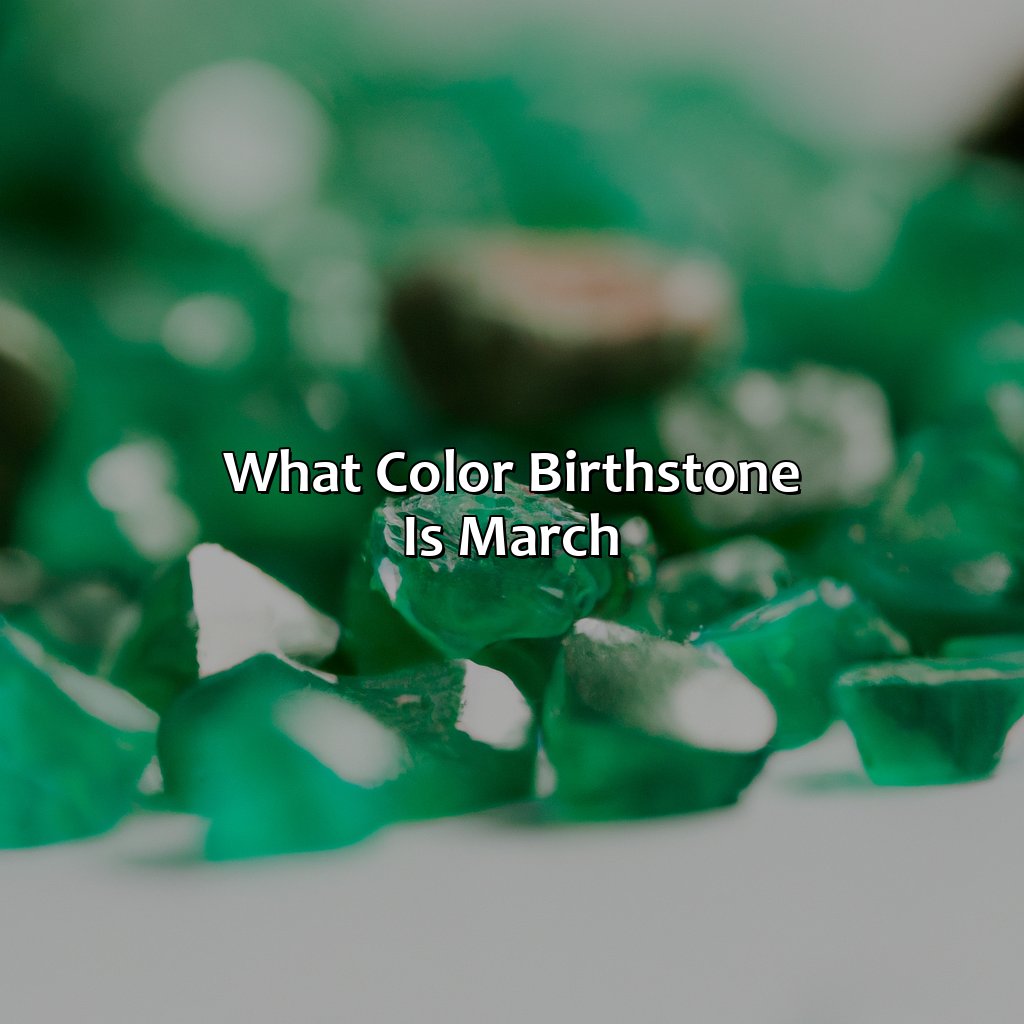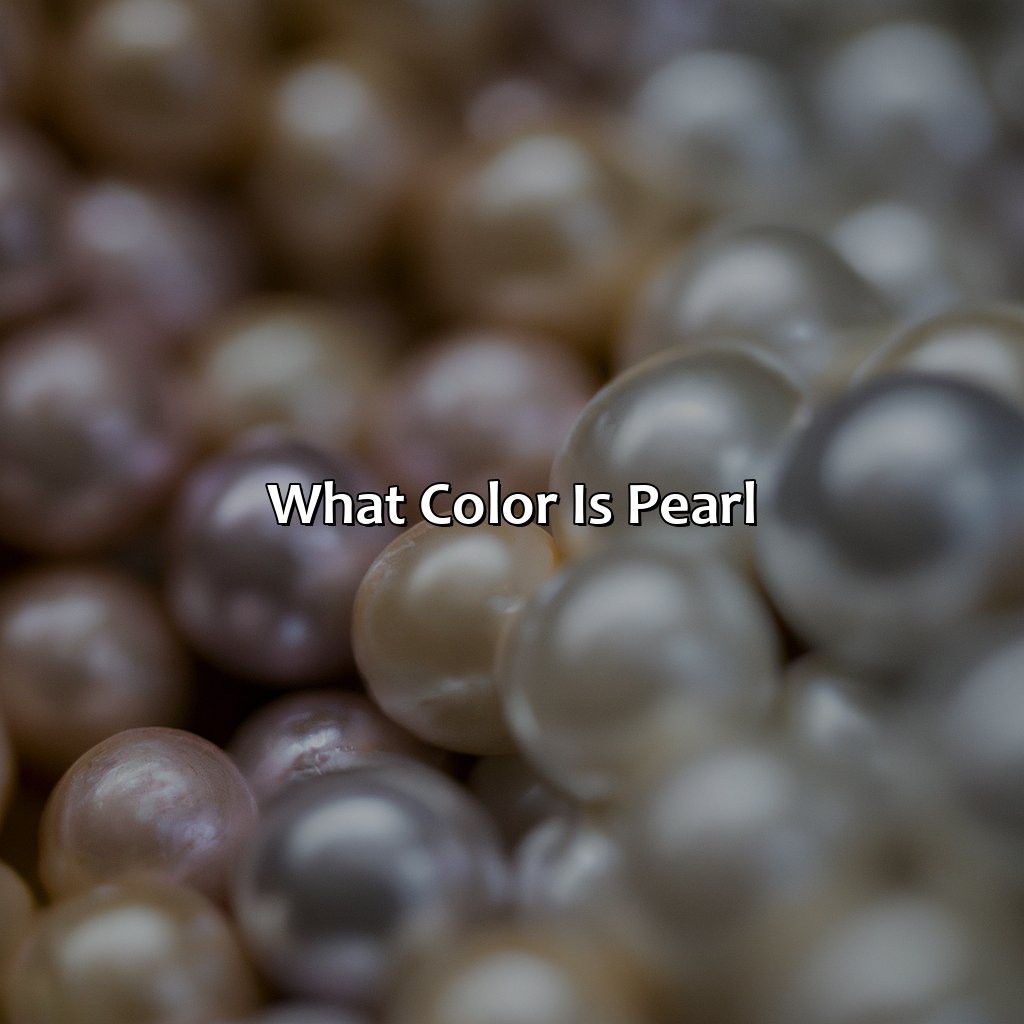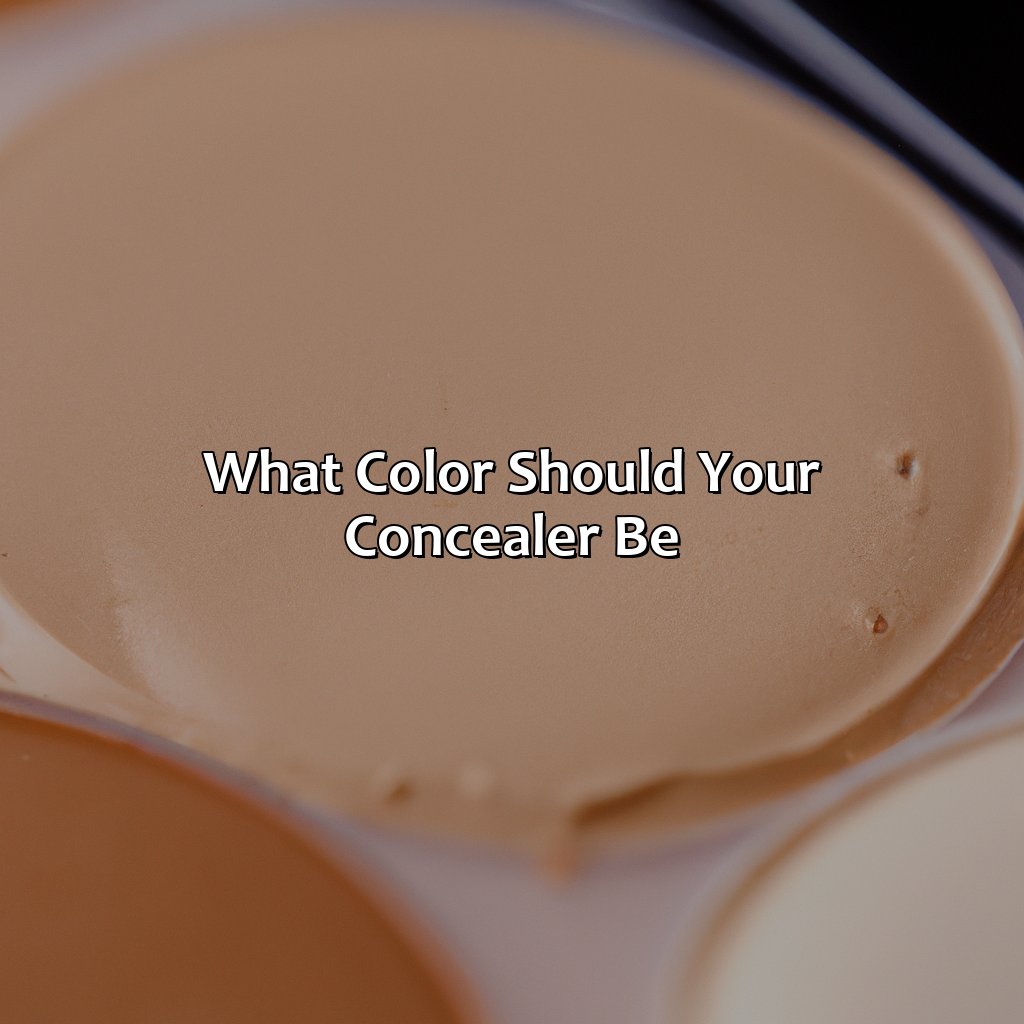Key Takeaway:
- Color psychology is a branch of psychology that explores the impact of color on human emotions and behavior. Various studies have found that different colors have the ability to evoke specific emotions and moods.
- Research suggests that happy colors are those that evoke positive emotions, such as joy, happiness, and contentment. Some of the happiest colors include yellow, pink, green, blue, and orange.
- Incorporating happy colors in home decor, clothing, and marketing materials can improve mood and evoke positive emotions in people. However, it is important to consider cultural and personal preferences when choosing colors.
The Science of Color Psychology

Photo Credits: colorscombo.com by Jerry White
Dig deeper into the psychology of color and its effect on emotions? Get to know color psychology! To get the most out of colors, it’s important to understand the theories behind them. In the following sections, explore the psychology of color and its influence on human emotions. Introduction to Color Psychology and The Impact of Colors on Human Emotions–these two will help you comprehend the colorful and complex human experience.
Introduction to Color Psychology
Colors have a significant impact on human emotions and behaviors, which has led to the development of the science of color psychology. It’s an area of study that deals with analyzing how different colors affect people’s moods, attitudes, and behavior. By studying color psychology, individuals can learn how to use color to their advantage and create the desired emotional response.
The influence of colors on emotions varies from person to person depending on several factors like culture, personal preferences, age groups, etc. For instance, blue may bring up feelings of calmness and relaxation for some people but can cause sadness in others. Hence it is essential to understand the power colors hold over our mood before using them.
Research has shown that certain colors have been linked to happier moods than others. Yellow – considered one of the happiest colors – is associated with positivity and energy. Pink induces soothing and calming effects that make it ideal for promoting happiness in your surroundings. Green comes as a natural stress-reliever while blue brings tranquility and helps relaxation. Orange has been found to keep individuals energetic or excited throughout.
On the other hand, there are colors that might make people feel less happy or demotivated like black – known for causing grief and sadness; gray- dull and depressing; brown- stagnant and boredom inducing.
Incorporating these happy colors into everyday life can be highly beneficial for your mood color spectrum since it uplifts positive feelings within yourself reflecting in colorful moods around your surroundings too! Home decoration by adding bright colored wallpapers or paintings can do wonders in uplifting spirits, clothing complimenting personal choice gives enthusiasm while effective use of logo branding images will attract customer attraction faster through marketing channels.
Color psychology acts as a potential tool to manipulate situations subtly where we interact with people daily without realizing its influence. Henceforth greater knowledge about such tactics makes usage smartened by understanding what creates an optimal response from each group individually for better engagement.
Colors not only reflect our emotions but also have the power to influence them; it’s like wearing your heart on your sleeve, only in the form of a hue.
The Impact of Colors on Human Emotions
Different colors impact human emotions differently, and the power of color symbolism can induce specific feelings and behaviors. Research on emotional color reveals that people associate lighter or brighter colors with positive emotions, while dark colors are more closely linked to negative emotions. For example, yellow is associated with positivity and happiness, while black represents sadness. Understanding emotional color enhances our ability to use this knowledge in daily life.
The use of a particular color can alter behavior or mood. Doctors have been known to use different colors in hospitals, calming blue walls for emergency rooms, stimulating red hues for study areas or patient’s rooms and green gardens as places for relaxation and rejuvenation. It is crucial to understand color psychology in advertising to convey a specific message because different colors influence perceptions of luxury, value, security or novelty.
Color schemes are often employed in home décor according to the homeowner’s tastes and preferences. Warm tones like orange evoke energy and excitement, ideal for dining rooms where guests congregate & festive events are held. Cooler shades such as blue create calm environments that work well for bedrooms or reading areas but not suitable when tranquility isn’t required.
To sum up: Colors have a profound impact on human emotion and behavior; color psychology enables precise perception of how we react based on the surrounding stimulus. Smart usage of Emotional Color serves as a tool in regulating ambiance perceived by others; countless spheres regarding color symbolism are still unexplored!
Science says yellow is the happiest color, but we’re not sure if that’s because it reminds us of sunshine or cheese.
Research on Happiness and Colors
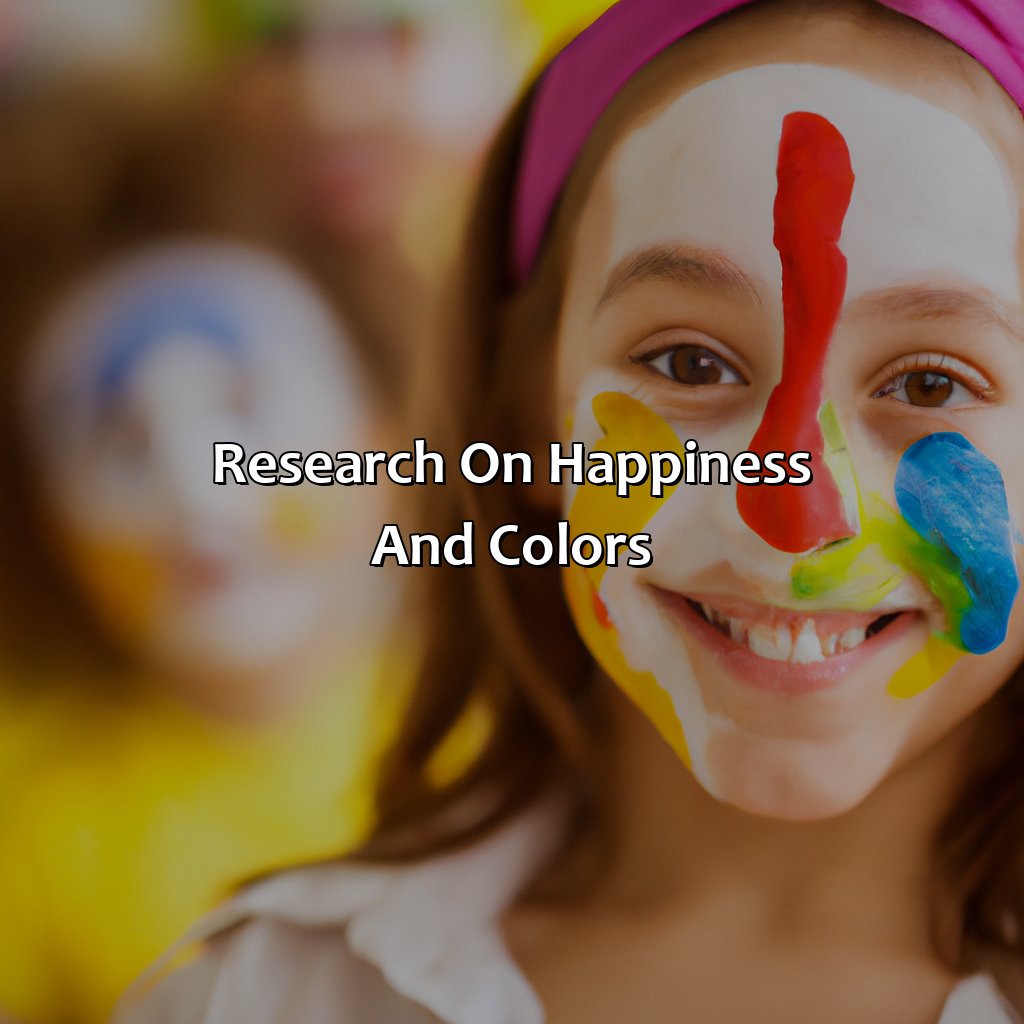
Photo Credits: colorscombo.com by Gary Perez
Gain a better understanding of the relationship between color and happiness! Dive into the research. We’ll explore two sub-sections:
- Studies on the connection
- The impact of various colors on happiness
Learn about the psychology behind color, warm/cool colors, bright/pastel colors, and complementary colors. Recognize the relevant color palette and chromatic scale to increase happiness.
Studies on the Relationship between Colors and Happiness
Numerous studies have been conducted on color psychology and its relationship with happiness. Here are some of the most compelling findings:
| Research | Findings |
| One study found that people rated bright colors as more joyful and happy than muted or darker shades. | Bright colors contribute to high levels of positive emotions, making them a preferred choice among individuals. |
| In contrast, another study found that pastel colors were associated with feelings of peace, happiness, and calmness. | Pastel colors such as pink and blue work well for individuals who prefer muted tones while still evoking feelings of happiness. |
| Red is known to stimulate excitement but can also create anxiety or aggression in some people. | This color should be used in moderation since it incites excitement but may not be ideal for everyone. |
Understanding which colors evoke certain emotions is vital when selecting appropriate hues that elicit desired responses. The psychology of color has a significant impact on how we feel and can influence our moods.
Color psychology research continues to evolve daily, uncovering new insights into the subtle nuances between different hues and their relationship with human emotions.
It’s important to note that individual preferences vary based on personal experiences and factors like culture, gender, and age. Additionally, choosing specific colors can yield different effects depending on the context in which they are used.
Make sure to stay up-to-date with new research developments in color psychology – so you can use the latest knowledge to improve your well-being and quality of life!
Bright, warm colors like yellow and orange can enhance happiness, while cool, pastel colors like blue and gray can have a reducing effect.
The Role of Different Colors in Enhancing or Reducing Happiness
Colors play a crucial role in determining human mood and emotional well-being. Different colors have unique impacts on emotions, and they can either enhance or reduce happiness. The impact of different colors on happiness can be seen in various fields.
The Role of Different Colors in Enhancing or Reducing Happiness is evident from studies that explore the relationship between different colors and mood changes. This study has found that warm colors like yellow, pink, and orange are associated with positive emotions like happiness, while cool colors like blue and green promote relaxation.
The following table shows the different types of colors, examples and their effects on happiness:
| Type of Color | Examples | Effect on Happiness |
|---|---|---|
| Warm Colors | Yellow, Pink, Orange | Enhance Happiness |
| Cool Colors | Blue, Green | Promote Relaxation |
| Bright Colors | Red, Orange, Yellow | Increase Excitement |
| Pastel Colors | Light Pink, Lavender, Baby Blue | Generate Calmness |
| Primary Colors | Red, Blue, Yellow | Energize Emotions |
| Secondary Colors | Green-Blue, Orange-Yellow etc. | Balance Mood |
| Complementary Colors | Opposite Ends of Spectrum (Red-Green etc.) | Create Contrast |
| Monochromatic Colors | Tints and Shades of One Color | Soothe the Mind |
Warm colors like yellow are known to increase positivity, while pink instills calmness by soothing moods. Besides this orange is associated with excitement and enthusiasm. On the other hand, blue is known for generating tranquility by inducing a calming effect over the mind.
A less explored aspect is how bright colors enhance excitement by energizing emotions while pastel colors bring forth serenity by promoting calmness. Primary colors such as red stimulate strong feelings while secondary hues like green-blue balance moods effortlessly. Lastly, complementing shades generate contrast while monochromatic tones soothe the mind with their chromatic scale.
Research has found that using happy colors in home decor, marketing and advertising can help boost the mood and increase the chances of a positive response from the public. For instance, restaurants use neutral hues for their walls to provide an intimate ambiance, whereas vibrant shades are used in stores to highlight discounts and special offers.
A true fact is that color influences up to 90% of people’s purchases, showcasing how vital it is for businesses to incorporate color psychology into their branding strategies (Source: kissmetrics.com).
Get ready to paint your world with joy, as we explore the happiest colors known to mankind.
The Happiest Colors

Photo Credits: colorscombo.com by Paul Sanchez
Uncover the happiest hues! This section brings you “The Happiest Colors”. Here, you can find colors that bring joy. Let’s explore:
- Yellow – bringing positivity;
- Pink – calming and soothing;
- Green – refreshing and relaxing;
- Blue – tranquil and serene; and
- Orange – energetic and exciting.
All hold the power of happiness!
Yellow: The Color of Happiness and Positivity
Yellow is a color that symbolizes happiness and positivity. It is a bright and cheerful color that evokes feelings of joy and optimism in people. This color is often used to uplift the mood and promote positive vibes in various settings, such as homes, offices, and public places.
Yellow, being a happy color, is often associated with sunshine, warmth, and energy. It is known to stimulate mental activity and enhance creativity by promoting a sense of clarity and focus. People who prefer yellow are said to be optimistic, confident, and enthusiastic.
Furthermore, the positive effects of yellow can be seen in its application in different contexts. In home decor, yellow can be used as an accent color to add vibrancy and cheerfulness to any room. In fashion, it can make a bold statement and convey confidence. In marketing and advertising, yellow is used to grab attention and create a sense of excitement.
However, it’s important to use yellow in moderation as overuse can have negative connotations like anxiety or agitation.
Historically, yellow has been associated with royalty and power across different cultures around the world. In ancient Egypt, only Pharaohs were allowed to wear garments made of pure yellow dye sourced from saffron flowers since it was considered sacred among Egyptians.
Feeling stressed? Paint the town pink with this soothing color of happiness.
Pink: The Soothing and Calming Color of Happiness
Pink is a color that is often associated with calmness and relaxation. Its soothing effect on the mind and body has been proven by numerous studies conducted in the field of color psychology. This soft and gentle hue has an immense impact on human emotion, making it one of the happiest and most positive colors. It is known to soothe and calm the senses, promoting feelings of love, care, and tenderness.
Research indicates that pink can decrease aggression levels significantly and promotes empathy towards others. The calming effect of this charming color is also beneficial in improving one’s mental health, reducing anxiety levels, relieving stress, and promoting a better mood. By enhancing compassion and kindness towards oneself and others, pink helps build a healthy mindset.
It’s interesting to note that while pink is associated with femininity, it does not promote sexism or gender bias. Rather than having a gender preference, its effect depends solely on individual preference. Therefore individuals who adore pink may benefit from incorporating it into their daily lives as it helps create a positive atmosphere around them without any form of judgment.
Pink was first discovered in 1947 by Eugene Chevreul when he mixed red with white to create what we know today as ‘pink.’ Since then, various shades have emerged to show off its versatility – light pink for infant nurseries, hot pink for sports teams’ logos or fashion statements. Nonetheless, no matter the shade or tone chosen; whether subtle pastels or vibrant hot pinks – each variant still holds onto its soothing nature qualities through its calming essence.
Feeling stressed? Go green – the color that refreshes and relaxes your mind.
Green: The Refreshing and Relaxing Color of Happiness
Green is known to be a refreshing and relaxing color that brings happiness to individuals. It has a comforting effect on people, making them feel at ease and calm. This is due to the fact that green is associated with nature, growth, and health. Moreover, this color signifies balance and harmony in life, which contributes to overall wellbeing.
In the field of color psychology, research shows that green has various positive effects on emotions such as reducing anxiety, increasing positivity and even boosting creative thinking. An interesting fact about green is that it’s often used in hospitals and clinics as it’s believed to aid healing and recovery processes.
Additionally, Green is a versatile hue that can be applied in myriad contexts such as home decor whereby incorporating plants or green furniture brings a sense of relaxation. In Fashion industry, Green-colored clothing can have the ability to soothe the senses of an individual wearing it.
Overall, incorporating more Green elements into daily lives can help improve mental wellbeing for both adults and children alike. This proves green as one of the happiest colors due to its calming nature.
Get lost in a sea of calm with the serene and tranquil blue of happiness.
Blue: The Serene and Tranquil Color of Happiness
Blue, a serene and tranquil color of happiness, has been proven to have a positive impact on human emotions. It is associated with peacefulness, calmness, and relaxation. The calming effect of blue is so profound that it even reduces blood pressure and anxiety levels in individuals. This makes it an ideal choice for interior design or decorating spaces that require tranquility.
In addition to its soothing qualities, blue has also been found to be related to creativity and productivity. Many companies incorporate blue in their branding as it promotes a sense of trust and reliability. Even nature uses shades of blue to create feelings of peace and calmness such as the ocean or the sky.
The use of Blue in historic paintings like Vincent Van Gogh’s Starry Night showed various tones of blues combined differently with other colors like yellow gave clarity, depth perception along with intensely deep emotions that remain nostalgic for centuries.
Overall, blue remains one of the happiest colors out there due to its association with positive emotions experienced by humans worldwide.
Get ready to feel the zest for life with the vibrant and dynamic energy of orange!
Orange: The Energetic and Exciting Color of Happiness
The color orange is an energetic and exciting hue that brings a sense of happiness to people. It is a bright color that stands out and creates enthusiasm. Orange triggers the emotions related to joy, warmth, comfort and zest for life. This makes it popular in advertising, clothing and home decor.
Studies show that orange enhances creativity, productivity, and optimism by increasing brain activity and making people feel more motivated. It is often associated with food as it stimulates appetite and can be found on many food labels.
Many brands use orange in their marketing materials as it attracts attention and signals affordability while stimulating excitement. However, using too much of this vibrant color can become overwhelming.
Interestingly, orange has different meanings across cultures; while Western countries associate orange with fall harvests or Halloween celebrations, Eastern societies view it as a symbol of luck in Buddhism.
In one instance, a businessman who incorporated an orange theme in his workwear felt an increase in confidence which led to new opportunities for expansion. The energizing impact of the color allowed him to connect better with his clients which improved his overall business performance.
Skip the black and gray, they’ll only bring your mood down – let’s explore the least happy colors around town.
The Least Happy Colors
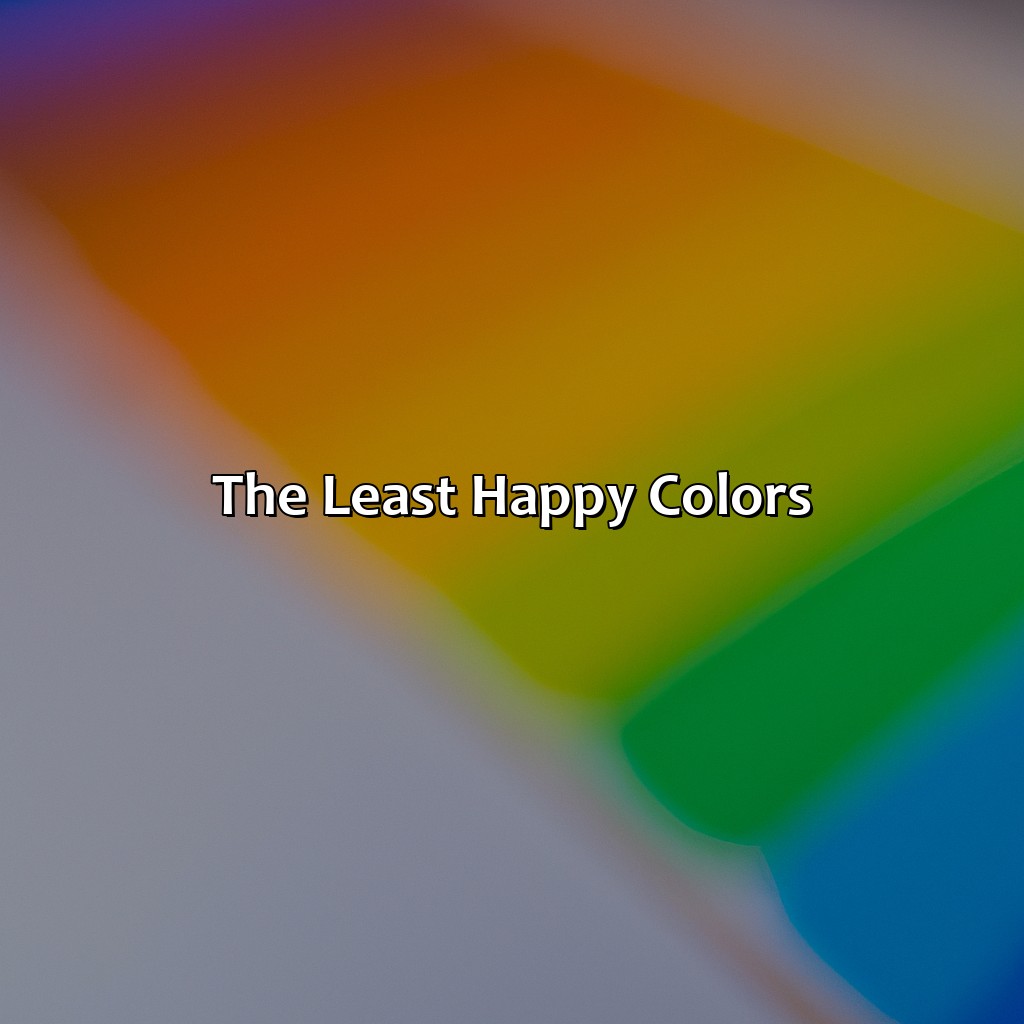
Photo Credits: colorscombo.com by David Nguyen
Let’s explore “The Least Happy Colors“! This part of “What is the Happiest Color” focuses on bleak and dull shades. We’ll look at the grief and sadness color – black. Also, depressing and dull hue – gray. Lastly, static and boring shade – brown. These colors evoke negative emotions.
Black: The Color of Grief and Sadness
The color black has been linked with grief and sadness for centuries, affecting people’s moods and emotions. This association with the darkest of all colors may be due to its connection with death. When mourning a loved one or going through a difficult time, people often wear black to signify their emotions and state of mind. Similarly, it is also common for people to use black in artworks and music videos that deal with sad themes. In Color Psychology, black is known as the color of grief and sadness due to its somber and melancholic connotation.
Interestingly, studies have shown that the color black can also evoke other emotions such as elegance, sophistication or power. It can also be used to portray rebellion or a sense of being edgy. However, in general, when it comes to psychology and emotional reactions, black’s representation overwhelmingly falls under grief and sadness. It should be noted that cultural differences play an essential role in these interpretations too.
For instance – While painting art or designing products for someone dealing with bereavement, it will be beneficial to avoid using harsh blacks but opting for warmer tones like dark grays or navy blues instead. Warm tones create feelings of stability providing emotional comfort while keeping the association of darkness subtle.
Therefore, applying dark brown paired with warm gold or bronze accents could bring the perfect blend between warmness and soberness giving appropriate depth without feeling gloomy.
Alternatively if you’re trying to uplift someone struggling through their darker days, shades of soft colors like teal-grey or off white can give an understanding feel yet still conscious about adding some calming vibe apart from just warmth making it more supportive but less depressing.
Looking for a color to match your mood? Gray: the color that screams I’ve given up without ever uttering a word.
Gray: The Dull and Depressing Color
Gray is a color that is often associated with dullness and gloominess. It has been found to have a depressing effect on human emotions and can lead to feelings of sadness and melancholy. Gray is often used in interior design schemes to create a calming and soothing environment, but its use should be limited as too much gray can have a negative impact on mood.
Studies have shown that exposure to gray can result in decreased levels of energy, decreased creativity, and increased feelings of boredom. The dullness of this color can cause individuals to feel uninspired and unmotivated, leading to lower levels of productivity.
Furthermore, the depressing nature of gray may also lead to physical health problems such as fatigue, headaches, and insomnia. This color has been associated with an increased risk of depression and other mental health disorders.
To combat the negative effects of gray, it is recommended to incorporate lively colors such as yellow or green into environments where people spend extended periods of time. These vibrant hues have been shown to increase energy levels, inspire creativity, and boost overall mood.
In fact, research has indicated that bright colors like yellow can help alleviate symptoms of depression by stimulating the release of serotonin in the brain. This makes them a great choice for areas like living rooms or offices where people work or socialize.
Despite its association with sadness and negativity, there are still ways that gray can be used effectively in design schemes. For example, light shades of gray can create a sense of calmness when paired with contrasting bright colors while darker shades can add depth and sophistication when used sparingly.
Source: https://www.ncbi.nlm.nih.gov/pmc/articles/PMC3673773/
Brown: the color that will make you want to take a nap faster than watching paint dry.
Brown: The Color of Stagnancy and Boredom
Brown: A Dull and Monotonous Color of Lifelessness
Often associated with earth, stability, and simplicity, brown is a stagnant color that can elicit feelings of boredom and lack of enthusiasm. It is a natural hue emanating comfort and warmth; however, it lacks liveliness and action, making it an unexciting color. It is considered the most unpopular color globally because it can also signify unpleasantness and dirtiness.
In comparison to more lively colors like blue, red, or green which symbolize vibrancy and enthusiasm, brown often displays monotony. The blandness of this dull shade may have calming attributes in some scenarios. Still, individuals suffering from depression or anxiety should avoid it as brown may bring on dreariness.
To breathe life into a dull environment that impacts mental well-being negatively, consider painting the walls with different shades like beige or taupe for warmer texture. Avoid using too much brown in your clothes as it may make you feel sluggish. However, incorporating other lively colors helps uplift one’s mood.
Incorporating more vibrant shades such as reds or pastel yellows near your workspace works best due to their invigorating effects on productivity levels. Adding textures that promote positivity like soft fluffy rugs reignite the soul into motion.
In summary, while brown is regarded as a comforting hue synonymous with security, its stagnant nature coupled with its associations with soil could be monotonous for many people-association wise giving birth to the branding perception for being boring businesses avoid implementing this colour for better-to-do appearance. Segregated environments (offices), i.e., desks or study rooms enhance productivity by evoking positive emotions that lead to creativity at work rather than invigorating the mind at once over monotonous effects. From home decor to marketing strategies, mastering color psychology can unlock the unlimited potential of happy color combinations.
Applications of Color Psychology

Photo Credits: colorscombo.com by Jerry Flores
To use color psychology effectively and come up with visually appealing color combos while keeping up with trends, you need to know the top combos. One of these is “happy colors,” which can create positive emotions. In this “Applications of Color Psychology” section, we will investigate how to use happy colors in home decor, clothing, accessories, marketing, and advertising. Sub-sections include:
- “Home Decor”
- “Clothing and Accessories”
- “Marketing and Advertising”
Using Happy Colors in Home Decor
Adding Colors to Your Home Decor
Using happy colors in home decor is a popular way of creating a lively and cheerful atmosphere. Colorful home decor can impact your mood and can help you stay positive throughout the day. Adding vibrant shades like yellow, pink, green, blue, and orange on walls, furniture or accent pieces can enhance the beauty of any living space.
Incorporating bright hues in curtains, rugs or pillow covers can be an excellent idea for those who don’t want to make big changes. Using color coordination between walls and decorative elements or adding colorful artwork can also create a great visual impact.
Adding indoor plants with vibrant green leaves will not only add a pop of color but will also give your interiors an eco-friendly touch. Another simple way to add happy colors in home decor is by using colorful crockery or table mats that complement other aspects of your interiors.
So why wait? Add these vibrant hues in your home decor today to experience all the positivity it brings! Turn heads and lift moods with colorful fashion that incorporates the happiest hues.
Incorporating Happy Colors in Clothing and Accessories
Clothing and Accessories in Colorful Fashion
Wearing happy fashion pieces is a great way to uplift our mood and exude positivity. Incorporating colorful fashion in clothing and accessories can be impactful in enhancing happiness levels. Here are some tips:
- Use vibrant colors in your wardrobe.
- Experiment with mixing and matching bright hues.
- Opt for cheerful prints and patterns.
- Accessorize with colorful jewelry, scarves, or bags.
- Don’t hesitate to try fun shoes like bright sneakers or sandals.
It’s important to note that the choice of colors expresses personality, cultural influences, and age factors. In the modern-day market, designers have integrated happy color tones using trend forecasting techniques that have translated into long-standing fashion lines. Colorful branding not only catches the eye but it also taps into the psychology of consumers, making them more likely to connect emotionally with your product or service.
Using Happy Colors in Marketing and Advertising
Colors play an essential role in marketing and advertising. The use of happy colors can attract customers, increase brand recognition, and enhance the overall appeal of advertising campaigns. Companies must implement a well-rounded color scheme that represents their core values and brand identity. Color psychology has a significant impact on designing logos, call-to-action buttons, and website backgrounds to influence customers’ purchasing decisions.
Color psychology in advertising focuses on using specific colors to elicit emotions in potential customers. Brands utilize different shades of colors in marketing and branding to ensure they are conveying the desired message. For example, red is chosen for speedy delivery services as it increases urgency within the customer to proceed with purchases. Blue is chosen for businesses that deal with trust-building factors such as insurance companies or financial institutions.
Incorporating color psychology into branding efforts distinguishes one business from another while increasing recognition among customers. A good understanding of color plays a crucial role in designing logos, letterheads, and other print materials unique to particular businesses. While selecting colors for designs, it is vital to consider factors such as culture and industry that would influence your target audience’s preferences.
Pro Tip: Ensure the color scheme aligns with your brand’s personality and image while keeping communication concise, clear, and visually stimulating.
Five Facts about the Happiest Color:
- ✅ The happiest color is yellow, which is associated with positivity, energy, and happiness. (Source: Forbes)
- ✅ Yellow is a popular color choice for creating a cheerful and inviting atmosphere in interior design. (Source: Elle Decor)
- ✅ Research shows that yellow can stimulate creativity and improve mood, making it a good color choice for workspaces and classrooms. (Source: Psychology Today)
- ✅ Yellow is often used in marketing and advertising to grab attention and convey optimism and confidence. (Source: Color Psychology)
- ✅ While yellow is associated with happiness, it can also be overwhelming at times and should be used in moderation. (Source: The Spruce)
FAQs about What Is The Happiest Color
What is the happiest color?
The happiest color is subjective and varies from person to person. However, research suggests that the color yellow is associated with happiness, energy, and optimism.
Can other colors also make you happy?
Yes, different colors can also create positive emotions and make you happy. For example, red is associated with passion and excitement, while green represents growth and harmony.
Why is yellow considered the happiest color?
Yellow is considered the happiest color because it stimulates mental activity, promotes feelings of happiness and joy, and increases energy levels. It is also associated with warmth and sunshine, which can create positive associations.
What colors should I avoid if I want to feel happy?
Colors that are associated with negative emotions such as sadness and anger should be avoided if you want to feel happy. These colors may include dark shades of blue, grey, or black.
How can I incorporate happy colors into my life?
You can incorporate happy colors into your life by adding colorful accents to your home or wardrobe. You can also choose to surround yourself with bright and cheerful artwork or choose to wear colorful clothing and accessories.
Can changing the color of my surroundings affect my mood?
Yes, research suggests that changing the color of your surroundings can affect your mood and emotions. Surrounding yourself with bright and happy colors can uplift your mood and increase your overall happiness and wellbeing.

